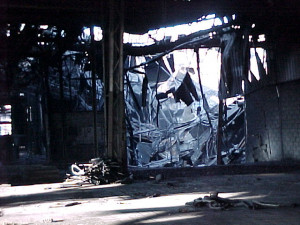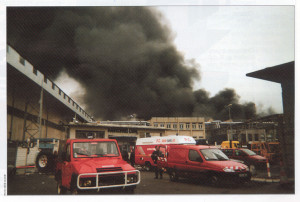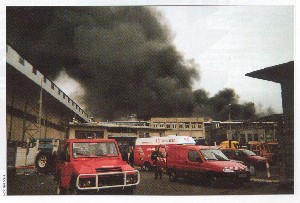In the basement of a 16,000-m² building of a tyre manufacturing plant, 3,000 m² of synthetic rubber (839 tonnes of butadiene/styrene, including 649 tonnes spread with petroleum oil and 1,170 tonnes of polybutadiene) combusted. At 4:40 pm, the alarm was sounded by an agent working for a subcontractor working on the ground floor. At 4:50, a heat alarm triggered the plant’s internal emergency plan. An initial assault on the fire at 4:55 pm by onsite fire crews proved ineffectual. The first responders only arrived around 5:40. The fire source, which was difficult to access, had already extended too far and within a few hours the fire had spread throughout the building. At 6:12 pm, a “deluge” type spraying was partially turned on for the basement (1/3 of the floor area), since the other valves remained inaccessible. A number of explosions occurred and 9 fire-fighters were injured, in particular while attempting to activate the rest of the building’s sprinkling network; a total of 1,400 tonnes of rubber had ignited, while 1,100 tonnes could be protected by the sprinkling system. Rubber pyrolysis continued for 44 hours, with the heavy smoke emitted necessitating the staggered intervention of 500 fire-fighters. On January 22nd around noon, it was announced that the fire had been fully extinguished. Property damage was extremely high, and the burned building had to be demolished.
This fire would have been caused by a molten metal spark during works using a blowtorch on the ground floor by a subcontracted employee who had been granted a hot work permit.
The analyses conducted during the fire on the quality of atmospheric air and the fire extinction water not captured and discharged via the plant’s output channel did not detect any extraordinary rise in pollutant levels traditionally sought (dusts, SO2/chemical oxygen demand (COD), suspended solids (SS), etc.).
On February 4th, the operator confirmed that 60 tonnes of a vulcanisation compound (vulcanox), along with 900 kg of cobalt hydroxide and 5.8 tonnes of rosin, also burned during the fire. Given the potential environmental and health risks, a major impact analysis and evaluation campaign was launched, under the supervision of a college of experts assembled on July 6th.
Apparently, a significant quantity of vulcanox had made its way into the sediments of both the BEDAT and MORGE streams, in addition to metals and polycyclic aromatic hydrocarbons (PAH). Environmental monitoring was also conducted. On April 27th, 2001, the college of experts completed their study of results from the most recent set of analyses and concluded that the environmental impact seemed to be small.
The operator updated the site’s safety report by incorporating domino effects and third-party expertise. This accident underscores the importance of: adapting fire protection resources (water, emulsifiers), appropriately designing retention basins, and acquiring up-to-date knowledge of stored hazardous products (type, quantities). The
Download the detailed report in .pdf format (392 Kb)






